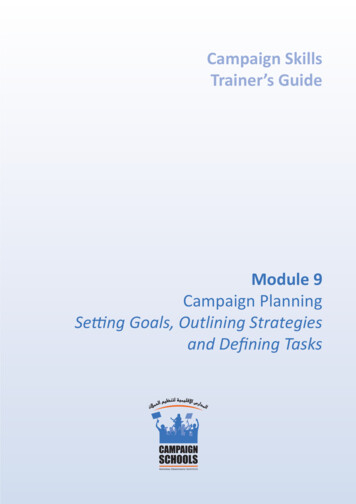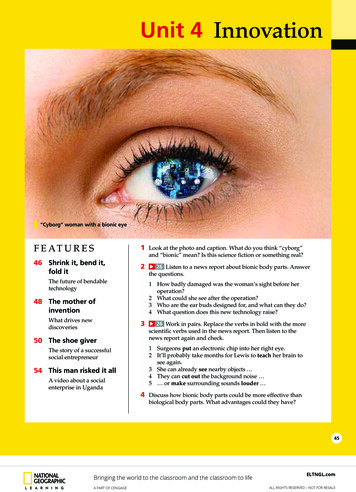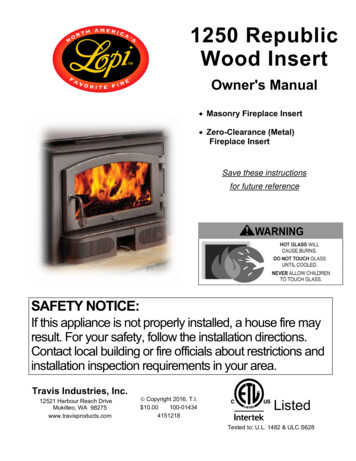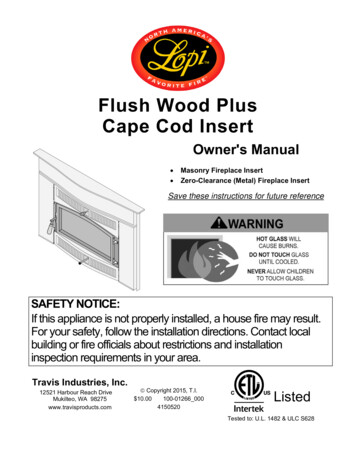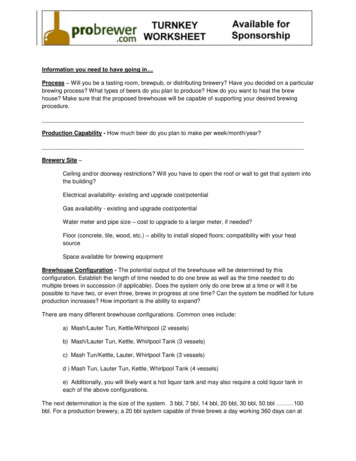
Transcription
Information you need to have going in Process – Will you be a tasting room, brewpub, or distributing brewery? Have you decided on a particularbrewing process? What types of beers do you plan to produce? How do you want to heat the brewhouse? Make sure that the proposed brewhouse will be capable of supporting your desired brewingprocedure.Production Capability - How much beer do you plan to make per week/month/year?Brewery Site –Ceiling and/or doorway restrictions? Will you have to open the roof or wall to get that system intothe building?Electrical availability- existing and upgrade cost/potentialGas availability - existing and upgrade cost/potentialWater meter and pipe size – cost to upgrade to a larger meter, if needed?Floor (concrete, tile, wood, etc.) – ability to install sloped floors; compatibility with your heatsourceSpace available for brewing equipmentBrewhouse Configuration - The potential output of the brewhouse will be determined by thisconfiguration. Establish the length of time needed to do one brew as well as the time needed to domultiple brews in succession (if applicable). Does the system only do one brew at a time or will it bepossible to have two, or even three, brews in progress at one time? Can the system be modified for futureproduction increases? How important is the ability to expand?There are many different brewhouse configurations. Common ones include:a) Mash/Lauter Tun, Kettle/Whirlpool (2 vessels)b) Mash/Lauter Tun, Kettle, Whirlpool Tank (3 vessels)c) Mash Tun/Kettle, Lauter, Whirlpool Tank (3 vessels)d ) Mash Tun, Lauter Tun, Kettle, Whirlpool Tank (4 vessels)e) Additionally, you will likely want a hot liquor tank and may also require a cold liquor tank ineach of the above configurations.The next determination is the size of the system. 3 bbl, 7 bbl, 14 bbl, 20 bbl, 30 bbl, 50 bbl 100bbl. For a production brewery, a 20 bbl system capable of three brews a day working 360 days can at
best make 21,500 bbls of beer. A ten day fermentation tank turnover time means 600 bbls of fermentationtank will be needed. Packaging 5 days a week for 50 weeks will require almost 90 bbls a day to beprocessed.(In my opinion, unless someone has cash in the bank, and can afford to invest with negative to zeroreturn for years, they should not buy a system looking too far in advance – better to get a system that willmeet your needs for the initial 2 to 4 years, then expand if needed – many a brewer have gone under dueto having too large a system and they can’t support it financially – and they’ll risk having beer go badbecause they can’t sell it fast enough in the beginning, further dooming their venture).Four daily brews is a potential production of 28,800 bbls. Five brews daily and you are up to 36,000 bbls.Another consideration can be whether you want to run 24 hours a day or only two shifts.Brewpubs and tasting rooms will focus more on variety and less on quantity. The brewery size for abrewpub or tasting room is a balance between annual volume and number of brews on tap at a giventime.Tank sizes also need to be determined. Fermenters are often sized for single brews, but it is very usefulto also have fermenters capable of holding two or three brews. The “footprint” of space needed for a 40bbl or 60 bbl tank is not much more than that of a 20 bbl tank. Larger tanks save space and cost less perbarrel to purchase. Smaller tanks increase the number of different recipes that can be in progress.Aging tank size (for lager breweries) is largely determined by the fermenter sizing.Brite tank size is determined by a combination of fermenter and/or aging tank size with the volumesplanned for daily packaging. Plan on at least one brite tank for every flavor you expect to package in asingle day. If you are canning or bottling, set up time can be significant, so the more flavors or barrels youcan fill in one day, the better.By example a 30 bbl brewhouse combines well with 30 bbl, 60 bbl, and 90 bbl fermenters. Having a 30bbl and a 60 bbl brite tank will then allow for processing any of the fermenters and provide for somepackaging flexibility. You should roughly expect to turn a brite tank over no more than once per day.Make sure the starting tankage is appropriate for your goals. Establish a workable plan to add additionaltanks for future growth, including their size and where they can be located.For comparison here are two examples that show some of the different needs of breweries.Example One, A Brewpub - Where you want many different beers on tap, using a very limited space.The space limitations often make it necessary for a brewpub to acquire all of its tankage day one, withexpansion possible only through using lots of racking to kegs.InitialBrewhouse, 4 fermenters, 4 brite tanks, some kegs1 yearBrewhouse, 4 fermenters, 4 brite tanks, lots of kegs2 yearsBrewhouse, 6 fermenters, 4 brite tanks, more kegs2 yearsBrewhouse, 6 fermenters, 8 brite tanks, more kegs3 yearsmaybe double size fermenters, and lots more racking
Example Two, A Production Brewery – Where you should have more space to add tanks, and probablywill have fewer active recipes in progress at any given time.InitialBrewhouse, 2 single batch fermenters, 2 double, 1 brite tank, kegs1 yearBrewhouse, more fermenters, aging tanks (if lagering), 22 yearsA 3 brite tank, more fermenters, aging capacity, and kegsndbrite tank, kegsrd3 years More fermentation and aging capacity, and more kegsSo we now have the system size and configuration established as well as the initial fermentation, aging,and brite capacities. Now we can establish the rest of the equipment.1) Grain Handlinga) The millb) An arrangement to add malt to the mill.c) An arrangement to move the malt to the mash tun.This can incorporate a grist tank to allow milling in advance of a brew and to speed upmashing in.d) Dust control?2) Watera) Hot Liquor Tankb) Cold or Ambient Water Tank (optional, depends on your local water temperatures)c) Water Purification System.Particle, carbon, sterile, reverse osmosis, pH adjusting, softening Look closely at yourwater supply and decide what if anything is needed. This will probably not come as part of thesystem but will be an add-on. A local supplier that can service it will usually be the bestchoice.d) Heat Source for the water and kettle.Flame, steam, electric, on demand, combinations? Who is responsible for the steam boiler?3) The BrewhouseMash, Lauter, Kettle, Whirlpool functions. Determine the need for venting the tuns and kettle tothe outside and who will supply the vent installation.4) Coolinga) Brewhouse - The heat exchanger configuration. 1 stage or 2 stage? Water, Cold water,glycol, other?b) Cold water tank? Is one needed or not? Jacketed? External heat exchanger?c) Heat recovery options with the cooling step, primarily hot water retention in the hot liquortank.5) Glycol Systema) Capacity. Is it large enough to cool the brews, hold the fermenter temperatures then crashcool them, and keep the brite tanks at 32-38 degrees – all at the same time? (Although, it iscommon to shut the glycol supply off to the jacketed tanks during knock out with a 2-stageheat exchanger). Will it allow for additional tanks and expansion, if needed?
b) Installation. Who will install the chiller unit? Who will install the piping to the brewhouse and tothe tankage? What materials will be used for the piping to the tanks? What size piping for theheader? What quality of insulation?c) Glycol. Size of reservoir. Who buys the initial charge of propylene glycol?d) Temperature Control System. How will the tank temperatures be sensed and controlled? Willthere be a central panel or controls at each tank? Which brands of controllers? What types ofvalves will control the glycol flow – solenoids, motor drives, other? And is the control systemand piping network expandable?6) Spent Grain Removala) How will the spent grain be removed from the lauter tun? Will a chute with an auger systembe provided?b) How will the spent grain be removed from below the lauter tun trap door?c) Where will the spent grain go? Will it be sent to a trash can, a trailer outside, or a spent graintank? How long will the auger need to be?d) Will the spent grain removal system be compatible with your location? It can be quite anuisance in the parking lot. Access, odors, flies, drainage . These often are afterthoughtsand can be major headaches later.The layout of the brewery needs to consider the positioning of truck access, the glycol chiller,grain silos, bulk CO2 tanks, spent grain removal, public parking and access, etc. and to makesure they are as compatible as possible.7) Tankagea) Fermenter considerations – Are the specifications good? Types and thicknesses of stainless steel, pressure ratings for the glycol jackets (30PSI is advised), pressure ratings for the fermenters themselves. (You do not want tohave to deal with tank or jacket failures, or with rusting.) Is the CIP setup sufficient and safe? Cone bottom for yeast removal or dish bottom? Type and placement of door? Sanitary sampling valve? Racking arm? Venting? Overpressure and vacuum protection? Pressure gauge? Thermowell locations not affected by yeast buildup? What valves come with each tank? Where can you obtain replacement door gaskets?b) Aging Tanks - For lagers. Same considerations as the fermenters without the same need fora cone bottom.c) Brite Tanks These may need a higher pressure rating than do fermenters. You will want to beable to safely hold 15 to 30 PSI headspace pressure (if the beer is cold enough, then15 psi will work). Suppliers will charge extra for a 30 psi rated tank. Your cellarpeople may want to operate the brite tank at the higher pressure. The liability of a
tank failure with resulting injuries makes the certification important. Insurance maynot cover a tank being knowingly used outside its pressure specifications.Brite tanks need to have a cooling jacket on the bottom of the tank so that thetemperature of the beer can be maintained at any fill level. They should have a sightglass so that the fill level can be monitored. They should come with a manway,valves, pressure gauge, carbonating stone, sanitary sampling port, and thermowell.8) FilterThe type and size of the filter needed is affected by the size of the system, brewing processes,and serving methods.a) A leaf plate diatomaceous earth filter is probably the most versatile and cost effective optionfor a brewery large enough to utilize it. A membrane filter can be used in conjunction with it ifa sterile filtration is desired.b) Pad filters. Buying pads, set up, and cleaning. These are more work and expense, but arebetter suited to smaller systems.c) Lenticular filter. Elements are available for coarse through sterile filtrationsd) Other filter types such as ceramic, membrane Make the supplier convince you of the merits of the filter they want to provide so you caninsure it is best for your purposes.9) Miscellaneousa) CIP system. Larger systems often have automated equipment to handle the chemicals usedfor cleaning the brewhouse and tanks. They may have it tied in with a brewhouse cleaningregime, especially to the cleaning of the heat exchanger between brews. This may be anoption that does not come with a standard package and will require negotiation if wanted.This is different than the CIP equipment that come standard in each vessel. Small to mediumbreweries will use the dirty portable pump and hoses used for the transfer to CIP the tank.b) Portable Pumps. A centrifugal pump on a wheeled cart is used for tank cleaning and somebeer movements. They are an indispensable part of every brewery. Having two is muchbetter than one. A spare makes maintenance much easier. Leaking seals can bedangerous? and can quickly ruin a beer via oxygen exposure. Ask for spare seals and makesure the brand of pump is one that you can get repair parts for.c) Fittings and clamps. Tees, elbows, triclamps, gaskets. You can never have too many.Setting up for cleaning just one tank can require several tees, elbows, and many valves. Toarrange for draining the tank, water flushing or cleaning different parts of the tank withoutexcess operator exposure to chemicals can call for some elaborate arrangements. Talk toyour brewer. He can give you an idea of how many will be needed at a minimum.d) Hoses. Sanitary beer hoses with triclamp connectors are not inexpensive. Make sure you getenough to operate the brewery without constantly moving hoses. The brewhouse will need adedicated hose that will reach the fermenters. The filter will need two hoses; one between thefermenter and filter and one to reach the brite tank. Tank cleaning will require several shorterhoses; tank to pump, pump outlet to tank, one to bring rinse water, and one to the drain. Morehoses will be needed for racking or bottling. And somebody probably just ran over one withthe forklift!Other fittings. Hose barb to triclamp fittings for CO2 movement and flushing. An industrial hose totriclamp fitting is very useful. You will want to have water available in the cellars via both industrial hose
connections and through triclamp connections. The industrial hoses are useful for washdowns, buttriclamp connections are better for the tank cleanings and line flushes. The triclamp connections willrequire more valves and gaskets.e) Other misc. A sanitary liquid meter is a useful tool to have in conjunction with tank filling andfiltering. The brewhouse will need an apparatus for adding either sterile air or oxygen to thewort prior to the filtration. Oxygen tanks and gas flow regulators can be sourced throughwelding supply companies if not supplied with the system.f) Lab Equipment. You will probably need to find your own lab equipment, but your turnkeysupplier may offer this. At a minimum you will need hydrometers for the brewhouse, a CO2volume tester to be able to measure the carbonation level in the brite tank, and equipment tobe able to follow the health of your yeast. Yeast care will at minimum call for a microscope, amethod to determine yeast viability, and a method to determine yeast cell counts forrepitching. The list of desired lab equipment can grow quickly to include pH meters,thermometers, bacterial plating equipment, centrifuges, spectrophotometers, bitterness andalcohol testing, dissolved oxygen, etc., etc. There have been impressive advances in labtechnology. Affordable, instant tests are available for checking bacteriological contaminationsthat would have been science fiction only a few years ago.10) Keg Washing and Fill.There is a lot of different equipment available for keg washing and filling. The degree ofautomation varies tremendously. There are choices on the chemicals used to clean and sterilizethe kegs, or even to utilize steam. The cost and value of this equipment varies considerably. Youwill need to do your homework on the particular equipment offered by the supplier. Determine itstrue value and whether it will have the proper support for servicing. The keg equipment may bean item it is better to outsource.11) CO2Bulk CO2 tanks are usually obtained in lease agreements with CO2 suppliers. You will want tomake sure the brewery layout includes a safe location for CO2 storage. Plan for CO2 lines to thecellar for maintaining head pressure in the fermenters, for the filter, brite tanks, and racking.Regulators will be needed. High capacity regulators that resist icing up are helpful at the britetanks for carbonation. Ask the turnkey supplier if they will supply CO2 regulators for the Britetanks. An ideal carbonation arrangement will include a regulator for the headspace CO2 beingvented in addition to the one controlling the CO2 flow to the carbonating stone.12) In Summary.Get everything in writing! Make sure all of the equipment to be provided is properly listed, including thespecifications ensuring the quality of the equipment such as the grades and thicknessesof stainless steel. Be picky. Don’t be afraid to specify exactly the brand of temperaturecontrollers, solenoids, or even clamps. Make sure all of the support services to be provided are listed. Have a listing of yourresponsibilities included as well. Eliminate the opportunities for misunderstanding ordisagreement. Proper documentation of the installation agreement, support services, and equipment tobe provided is important as it is your best guarantee that you will get the system you have
been promised and are paying for. If the installation goes badly these documents will beyour lawyer’s best weapon.Make sure the payment plan for the system is reasonable. It should reflect the progressof the project. Do not overtrust by overpaying early on. The actual presence of equipmentis your first receipt of a tangible asset. Before that you are relying largely on trust andsupplier reputation. Escrow accounts can protect the supplier and ease their concernsbut be careful on how payments are triggered and authorized.Insist on some kind of protection from the perils of an overlong delivery and delayedinstallation. Penalty clauses and/or having a relatively large portion of the overall billbeing paid only at the completion of the install can do this, but may be difficult to obtainfrom established suppliers.Keep your brewer involved in the design of the brewery, the equipment specifications,and in the installation. Brewer input can prevent many problems from occurring. It alsohelps by ensuring the brewer is knowledgeable and comfortable with the brewery,which in turn increases the probability that the brewer will make flawless brews.A last consideration - Invite me over for a beer or six when you have most of the kinksworked out. Please.Supplier References.Every business has detractors but it’s always good to get a heads up from your fellow brewers.Reference BreweriesPayment Structure – Are the payments triggered by agreed upon milestones in the construction phase,such as the equipment shipping or arriving to the site? How much is required in advance? Is theappropriate amount of the payment due as the project is nearing completion? The supplier will typicallywant to avoid a negative cash flow situation during the project.Penalty Clause - Is the supplier willing to include a penalty clause in the contract for failure to meetdelivery times. Penalty clauses do not have to be punitive. If a company is promising delivery in 12weeks, then requesting price concessions after 18 or 20 weeks is reasonable. Solid suppliers should beable to work with you to structure a reasonable agreement that will ensure a timely delivery yet safeguardboth of your companies financially. Companies unwilling to consider a penalty clause could have difficultymeeting promised delivery times. If you ask for a penalty clause, in return a supplier might ask for abonus for meeting or beating a promised delivery date or some other desirable goal.Support - What support will be provided in the installation? Nail down exactly what is being offered. Inwriting. (Truck unloading, Equipment Movement and Assembly, Tank Leveling, Glycol pipe installation,etc.)
For a production brewery, a 20 bbl system capable of three brews a day working 360 days can at . best make 21,500 bbls of beer. A ten day fermentation tank turnover time means 600 bbls of fermentation . Glycol System a) Capacity. Is it large enough to cool the brews, hold the fermenter temperatures then crash .

